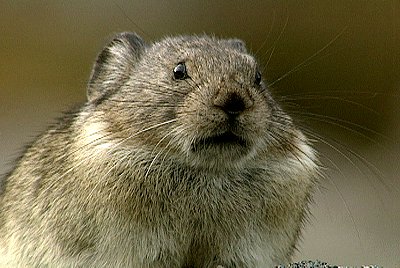 Have you ever photographed a pika? A who? A pika? When I asked a young wildlife photographer that question in Alaska’s Denali National Park, I got the standard response, “What the hell is a pika?” Most folks don’t really know this little leprechaun of the high country, so I’ll tell you about it. It is one of the least known mammals in North America.
Have you ever photographed a pika? A who? A pika? When I asked a young wildlife photographer that question in Alaska’s Denali National Park, I got the standard response, “What the hell is a pika?” Most folks don’t really know this little leprechaun of the high country, so I’ll tell you about it. It is one of the least known mammals in North America.
Actually, there are two species of pika: the collared pika found in Alaska and the Yukon and the regular pika found in the Rocky and Sierra Nevada Mountain ranges of Canada and the U.S. As its name implies, the collared pika does have a rather indistinct, light cream colored band encircling its neck behind its ears.
The pikas belong to the family LEPORIDAE, along with the hares and rabbits. Some folks refer to the pika as a rock rabbit. The LEPORIDAE were split off from the rodents when it was discovered that they had two small, absolutely useless teeth behind their incisor teeth in the top jaw. The pikas are only six to eight inches in length and have large, rounded ears and no visible tail. They shade in coloration from dark through light gray and from a tan to brownish-gray.
The regular pikas, living in a more southern region, usually have two litters of young per year, while the collared pikas, living further north, usually have only one. If you see an adult pika or a young pika by itself, you can always tell them apart because the adult takes most of the summer to shed its last winter’s coat of longer hairs. The shedding starts at the nose and progresses toward the tail in an almost vertical line over the rest of the body. Not only is it easy to see this difference in hair length, the new coat is darker in coloration than the winter hair which has been bleached lighter through exposure to the sun.
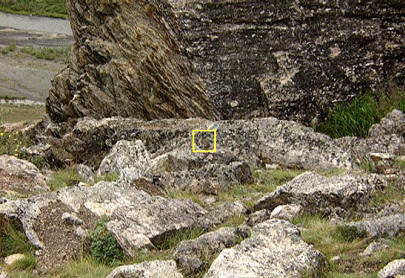 Pikas are creatures of the talus slopes; they always live in the jumble of rocks that have been split off from the mountain peaks by frost action and expansion & contraction of exposure. The pikas live in colonies and, where you find one, you may find a dozen more, although they will be widely scattered across the slopes because each animal does have a small territory it claims as its own. However, I’ve never seen any sign of aggression when one pika trespasses on another’s territory.
Pikas are creatures of the talus slopes; they always live in the jumble of rocks that have been split off from the mountain peaks by frost action and expansion & contraction of exposure. The pikas live in colonies and, where you find one, you may find a dozen more, although they will be widely scattered across the slopes because each animal does have a small territory it claims as its own. However, I’ve never seen any sign of aggression when one pika trespasses on another’s territory.
It has been amply documented that the pikas will help one another when they are being chased through their rocky warrens by their deadliest enemy, the weasel.
Researchers have seen different pikas run in front of the weasel, to allow the pika that the weasel had been chasing, to escape and rest. Adults, especially, will divert the weasel when it is chasing one of their young. The weasel is the only predator that can actually go anyplace a pika can go. Bobcats, lynx, foxes, coyotes, wolves, hawks and eagles all will take a pika whenever the opportunity presents itself, which really isn’t very often. As the pikas are strictly diurnal, the owls are not considered a predator of them.
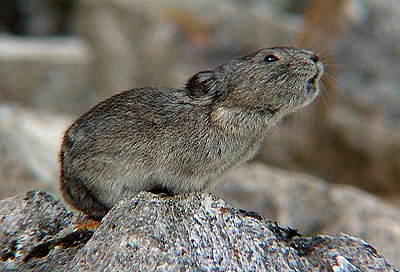 As a defense against any and all predators, the pikas have a colonial warning system. In any colony, one or more pikas will usually be sitting on the peak of some large rock, just resting and soaking up the sunshine. While doing so, they are also on guard duty. Everything, anything, that moves within their range of vision, which is excellent, is spotted and the alarm chirps are given. In fact, you will probably hear the pikas long before you see them and you’ll hear them far more often than you will see them. The chirp is a short, fairly high-pitched staccato bark that is given constantly, with about ten chirps to the minute, for minutes on end. You would think that such constant chirping would allow you to instantly pinpoint the pika’s whereabouts. Not so.
As a defense against any and all predators, the pikas have a colonial warning system. In any colony, one or more pikas will usually be sitting on the peak of some large rock, just resting and soaking up the sunshine. While doing so, they are also on guard duty. Everything, anything, that moves within their range of vision, which is excellent, is spotted and the alarm chirps are given. In fact, you will probably hear the pikas long before you see them and you’ll hear them far more often than you will see them. The chirp is a short, fairly high-pitched staccato bark that is given constantly, with about ten chirps to the minute, for minutes on end. You would think that such constant chirping would allow you to instantly pinpoint the pika’s whereabouts. Not so.
The chirps have a ventriloquistic quality to them and it’s extremely difficult to pinpoint where the sound is originating. And, although the pikas uttering those alarm notes are usually sitting right out in the open, their small size and the fact that their coloration matches the rocks on which they are sitting makes them extremely hard to locate.
Once you have located a pika, taking its photo is comparatively easy; all it takes is time. When the pika knows it has been discovered, it will dash off and be gone in a blink of an eye and that’s quicker than a click of a shutter. Use your biggest lens and a teleconverter. As you will often have very good light and the altitude will allow for an even higher exposure number, you do not have to use a fast film.
Being diurnal, the best time to photograph pikas is early in the morning because, after fasting all night, they want to breakfast and will feed immediately after sun-up.
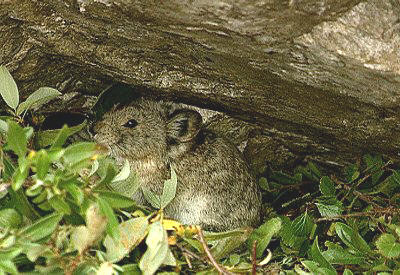
A pika with a winter food pile
Just stand still, absolutely still, and within minutes the pika will probably pop out of the talus somewhere. Any movement on your part will send the little critter diving for cover, only to reappear elsewhere a short time later. You have to get used to the idea that the pika seldom reappears where it disappeared. Most burrowing creatures have no choice but to come out of wherever they went in. That’s not the case with the pika. Because they live in talus piles, the pika can run under and through the tumbled stones almost anywhere. It is part of the pika’s survival tactics, not to come out from under the same stone where it went in. By not doing so, the pika avoids being taken by a predator that is patiently waiting at the hole the pika entered.
Although the pika are busiest about one hour after dawn, they are active all day long. Not being a hibernator, as are most of the ground squirrels and marmots that share their terrain, the pika not only has to eat for today but has to cut and store food to be used in the winter when snow buries the mountain tops.
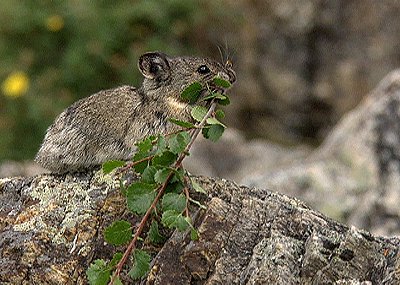 So, all through the day the pika cuts grasses, forbs and the tips of leafy bushes and stores them in different piles under protective rocks where they will dry and can be used for food through the long winter season when nothing is growing. Discovering these winter food piles means you are in the core of the pika’s territory. Make sure you photograph the food piles as “support” photos; these will be needed if you have a chance to sell your pika photos.
So, all through the day the pika cuts grasses, forbs and the tips of leafy bushes and stores them in different piles under protective rocks where they will dry and can be used for food through the long winter season when nothing is growing. Discovering these winter food piles means you are in the core of the pika’s territory. Make sure you photograph the food piles as “support” photos; these will be needed if you have a chance to sell your pika photos.
If you get to Denali National Park in Alaska, you will be able drive the fifteen paved miles to the parking lot at the Savage River. Directly behind the parking area is a spine of rocks about three hundred feet high that I call “Pika Peak” because it is the best spot I know of to photograph the collared pika. They will be found at the bottom and on either side of the spine. You will have better light on the south side of the spine but, because the main trail to the top goes past that side, the pika will be disturbed by the dozens of tourists hiking the trail.
If you have a photographer’s permit, or take the bus into the park, get off at the viewing area at the top of Polychrome Pass and walk back down to the second major loop on the East Fork side. There, you don’t have to climb at all, the pika are in the talus piles that make up the roadbed itself.
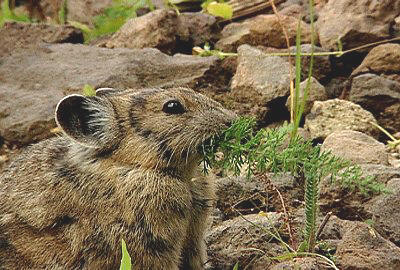 In Glacier National Park, Montana, the regular pika can be found along the eastern portion of the Going to the Sun Highway. Pull out on the roadside turnoffs and watch the talus slopes on either side of the road. As the road is basically an east – west road, you will have to get off the road and get below the pika, if you find them on the south side, to get the light behind you.
In Glacier National Park, Montana, the regular pika can be found along the eastern portion of the Going to the Sun Highway. Pull out on the roadside turnoffs and watch the talus slopes on either side of the road. As the road is basically an east – west road, you will have to get off the road and get below the pika, if you find them on the south side, to get the light behind you.
There are quite a few pika around the Visitor Center at the top of Rocky Mountain National Park in Colorado. Leave your car in the parking lot, climb over the wall on the opposite side of the road and make your way out among the rocks and shoot back toward the wall. This is also an excellent spot to get photographs of the yellow-bellied marmots and Clark Nutcrackers.
Now that the bus service has been discontinued up Mt. Washburn, you will have to work to get photographs of the pika in Yellowstone National Park. Leave your car in the parking lot and carefully check on the slopes as you walk up the road toward the peak. I have always found most of the pikas up near the top of the peak, but then I usually worked from the top of the peak down. The entire roadside, being above the timber line, should be a home site for the pika.
Will you be able to sell a lot of pika photos? No. Will you be able to sell any pika photos? Perhaps.
I have never taken photos on the basis of whether or not I could sell them, although I always hoped I could. My greatest pleasure in life is looking at ALL wildlife though a viewfinder and photographing pika has given me lots of pleasure.
by Dr. Leonard Lee Rue III

Leave a Reply